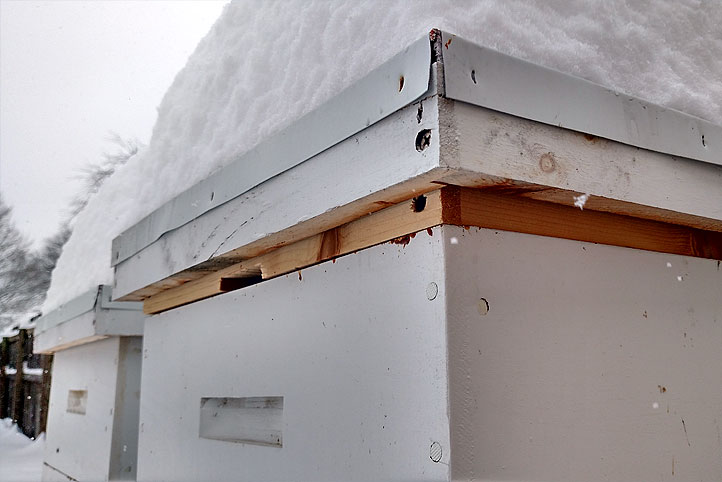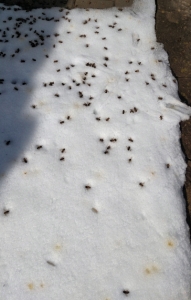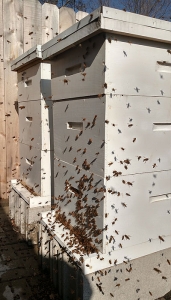
It’s a bone-chilling 9°F (the high for today) as I write this post.
Not 11 days ago, we had a taunting peek at Spring. It was 57°F and sunny when I snapped these photos and sent them to family.
Replies ranged from a (jestful) “Global warming?” to our growing and “leggy” 5-year old. And, not surprisingly…
“What are the bees doing, with no flowers to visit?”
Great question, it’s the middle of February.
So, what do bees do in winter? It’s a question I’ve heard from several friends over the past months. The answer is one I still find fascinating…
Bee Warm
Whereas many insect adults die, migrate, or hibernate through winter, the honey bee colony remains active.
By itself, a singular honey bee is exothermic (cold-blooded).
By huddling together as a “winter cluster,” bees on the outside of the cluster act as an insulating shell, trapping the heat of the cluster. The colder the temps, the tighter the cluster. And when cuddling isn’t enough to stay warm, the cluster can crank up the heat by vibrating their wing muscles. This shivering comes at a cost. More fuel (honey) is consumed and metabolized, but this was already planned for. Despite what some might think, honey bees don’t store up honey for you and me, but as a cache to make it through the winter months when nectar and pollen aren’t available. In temperate zones (like Illinois) bees consume between 60–80 pounds of honey to get them through winter.
But what about those occasional warm winter days. What do they do then?
In short…winter chores.
Bring out yer dead!
Honey bees are extremely clean and known for their hygienic behaviors. This is usually associated with the removal of dead, dying or diseased brood through the productive months, but bees will jump at any chance to clean house. Even in the dead of winter. (Sorry, couldn’t resist.)
Here’s video I took of an “undertaker” bee hauling out her dead sister on that 57°F day.
Personally, I can’t observe this activity without thinking of the equivalent scene from the classic Monty Python and the Holy Grail. But I’m weird like that.
The sight of hundreds of dead bees outside the hive entrance could be cause for alarm for a beekeeper, but in most cases, it is just natural attrition. Depending on climate, the size of a colony could drop from 60,000 bees at the peak of summer, down to 10,000 by the start of spring. Of course, if numbers get too small or they run out of food stores, a colony runs the risk of being overwhelmed by the cold temps resulting in a “dead-out.”
Potty Break

Another task occurring on warmer days in winter are “cleansing flights.” Honey bees are extremely hygienic and will not defecate in the hive unless they can hold it no longer (or are sick with dysentery). When ambient air temps allow, bees will briefly leave the cluster in order to void themselves immediately outside the hive. This frass (the technical term for insect poop) is especially apparent when there is snow on the ground. What is relief to the bees is also a strangely delightful sight for the beekeeper. They’re still alive!
Many cite 50°F (10ºC) as the temperature which prohibits flying, but I’ve witnessed a daring bee make a cleansing flight at 26°F (and return to the hive). (It’s a risky move. A moment too long and the flight muscles seize up, leaving one less body to create and share warmth.) But when you gotta go, you gotta go!
But when you gotta go, you gotta go!
Make More Bees!
Except for a brief egg-laying respite (termed the “broodless period”) during November and December, the queen’s principal duty resumes in late December, regardless of outside temps. Sensing the longer hours of sunlight following the Winter Solstice (December 20–23), the winter cluster raises the core temperature from a broodless 75°F to a brood nest temperature of 94°F. This added warmth, along with increased feeding of the queen, stimulates her to begin laying again—though just a few eggs at first.
Maintaining a constant brood rearing temperature requires greater food consumption. This can become problematic especially when food stores are getting low. If food is not withing reach of the cluster a colony will perish, as the colony will not leave the brood to the elements and will remain “stuck on brood.” This can happen when there is a small population which is unable to cover their stores adequately.


